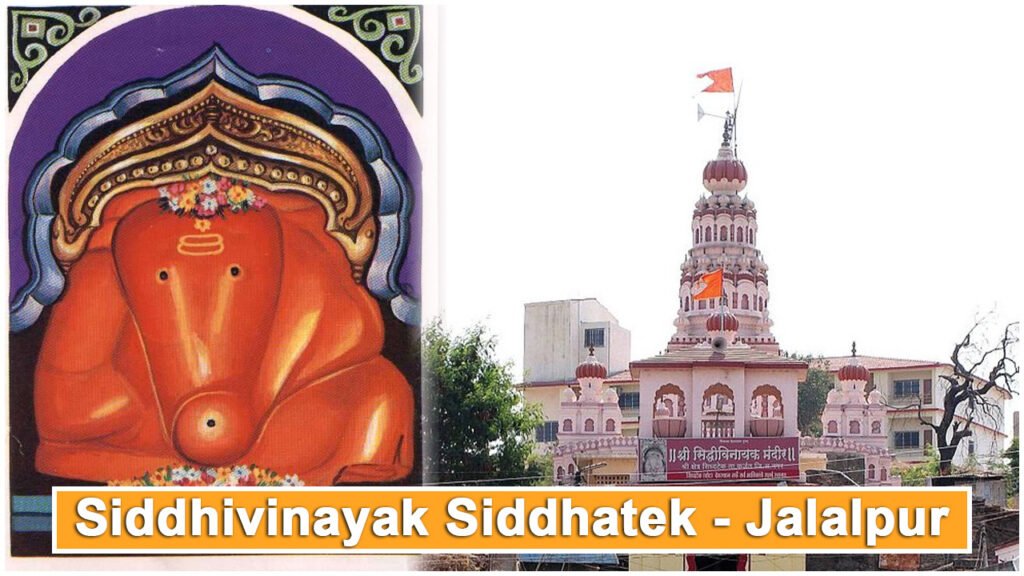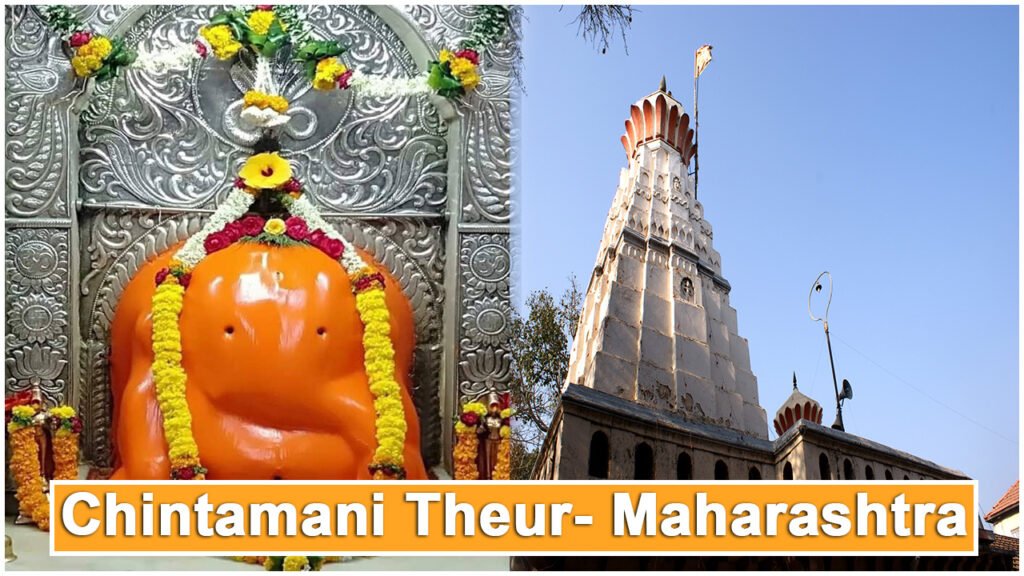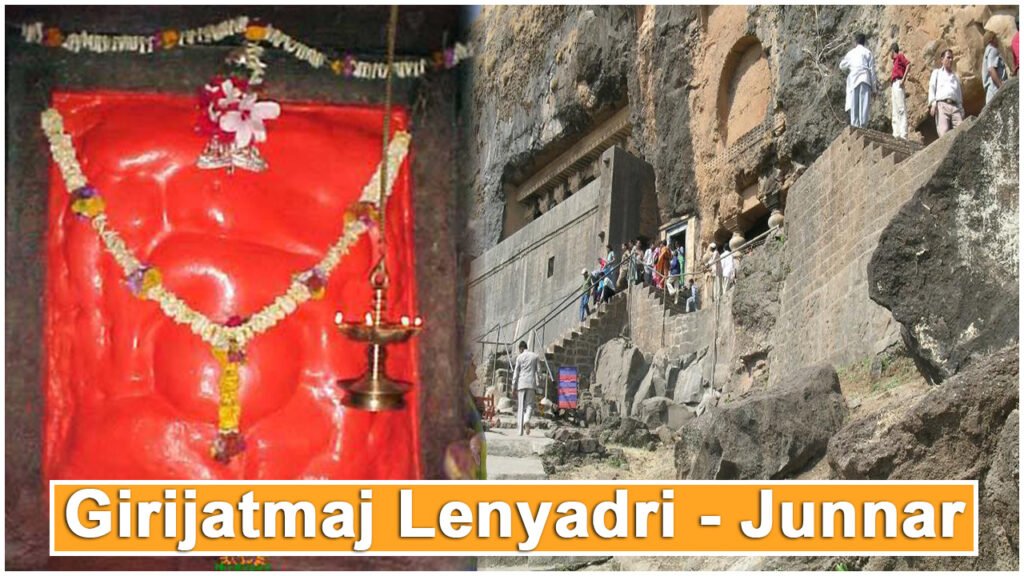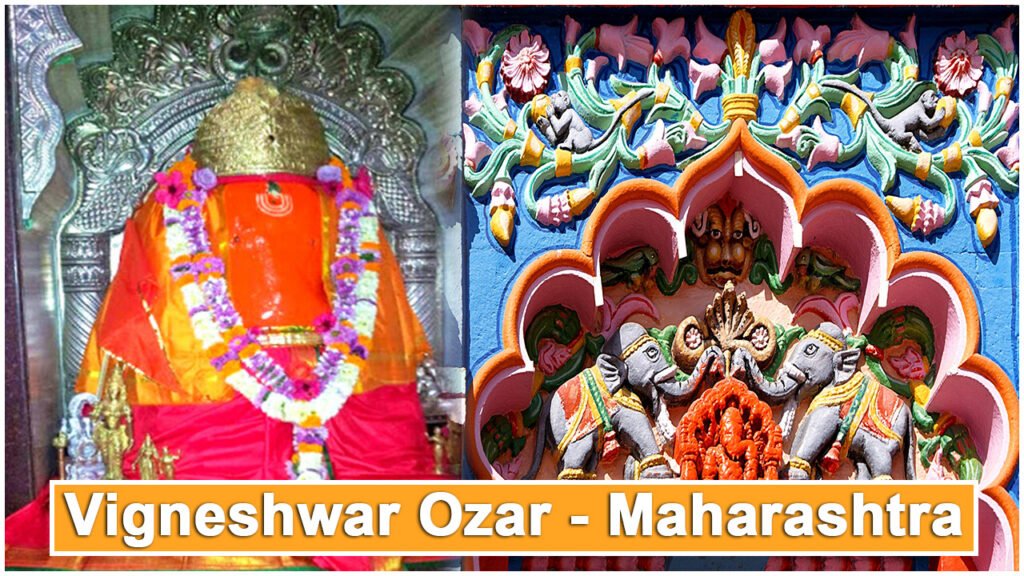Ashtavinayaka literally means “eight Ganeshas” in Sanskrit. Ashtavinayaka yatra refers to a pilgrimage to the eight Hindu temples in the Maharashtra state of India that house eight distinct idols of Ganesh, in a pre-ascertained sequence. The Ashtavinayak yatra covers the eight ancient holy temples of Ganesh which are situated around Pune. Each of these temples has its own individual legend and also history, as distinct from each other as the murtis in each temple. The form of each murti of Ganesh, as well as His trunk, are distinct from one another.
1. Mayureshwar Morgaon Ganpati Temple
The main temple that one should visit throughout the Ashtavinayak tour is the Mayureshwar Ashtavinayak Temple located at Morgaon near Pune. This is the starting point as well as the ending of the journey. The temple is a black stone structure constructed during the reign of the Bahmani Sultanate (14th– 16th century).
The Temple has 4 gates constructed with a small Islamic architectural influence. The 4 corners have minarets presenting the look of a mosque. 8 idols of Lord Ganesha grace the 8 directions or corners of the Temple. They are of the form of Ekadanta, Mahodar, Gajanana, Lambodar, Vikata, Vignaraja, Dhumravarna, and Vakratunda.

Legend of Morgaon Ganpati Temple
The King of Mithila, Chakrapani, and his wife Ugra were childless for a long time. They prayed to Lord Surya for a child. He was appeased and blessed with a child named Sindhu. He was blessed with the full bowl of Amrit as a boon and was reminded that he would remain immortal as long as the bowl remained unbroken.
Sindhu swallowed the bowl to protect it. He turned into a corrupt demon that terrorized and kept even the Gods as captives. The Gods approached Lord Ganesha for help. He descended to Earth on a peacock and slew the demon, took out the bowl from his stomach, and broke it. Morgaon is believed to be the place where the head of the demon Sindhu fell on Earth.
Significance of Morgaon Ganpati Temple
The Ganesha Purana reveals the legends and the significance of Morgaon in as many as 22 chapters. It is considered that Morgaon is among the 3 extremely spiritual sites for Lord Ganesha, the other 2 being Mount Kailash in the Swargaloka and Adishesha’s home in the Pataal Loka. It is also considered that at the time of Pralaya or the End of the World, Lord Ganesha will take and appear home here.
It is considered that the original idol of Lord Ganesha was consecrated here by Lord Brahma himself. The idol was small and made from sand, iron, and diamonds. Ultimately, the Pandavas confined this idol in a copper sheet and placed it behind the presently worshipped idol for safekeeping.
The idol of Lord Ganesha is unique. He is represented in a sitting posture with 3 eyes and the trunk dealing with the left side. The eyes and the navel are adorned with diamonds. The Nagaraj can be seen on the top along with Buddhi and Siddhi on either side.
Morgaon Ganpati Temple Timings
| 05:00 AM To 10:00 PM |
2. Siddhatek Ganpati Temple
The second temple in the Ashtavinayak series of Temples devoted to Lord Ganesha is the Siddhivinayak Temple located at Siddhatek in the Ahmednagar district of Maharashtra. The Temple is located on a hillock beside River Bhima.

Legend of Siddhatek Ganpati Temple
According to the legend, the devils Madhu and Kaitabha originated from the ears of Lord Vishnu during his Yoga Nidra (a state of awareness between awakening and sleeping). The 2 devils got a boon from Goddess Shakti as per which they can not be eliminated by any Deva or Asura unless they wish to die willingly.
At that time, Lord Brahma was considering the creation of the universe for which he required the Vedas. The devils thieved the Vedas from Lord Brahma. Lord Brahma requested Lord Vishnu for help. Lord Vishnu awakened from his deep sleep and took the form of a Hayagriva (a horse-faced creature).
The fight between the Hayagriva and the 2 devils lasted 5 thousand years. Lord Vishnu understood that these devils were invincible till they were eliminated from the boon given by Goddess Shakti. He was also suggested by Lord Shiva to see the blessings of Lord Ganesha before slaying the devils.
It is believed that Siddhatek was the place where Lord Vishnu requested Lord Ganesha’s blessings which the latter offered happily.
Significance of Siddhatek Ganpati Temple
- It is believed that Lord Vishnu himself constructed the original unique four-door temple dedicated to Lord Ganesha. However, due to natural reasons, the temple perished. Under the Peshwa rule, the temple was reconstructed and consecrated with the original idol.
- The idol of the deity is Swayambhu in nature, 3 feet tall and 2.5 feet wide. The trunk is turned towards the right representing the fierce form of Lord Ganesha. The idols of Riddhi and Siddhi are placed on one lap. The idols of Jaya and Vijaya, who are the gatekeepers of Lord Vishnu’s abode Vaikuntam flank the Lord on both sides.
- This is the only temple among the eight Ashtavinayak Temples where the trunk of Lord Ganesha’s idol is turned towards the right. It is a belief that this Lord is difficult to please but grants Siddhi (Success) to the devotee.
Siddhatek Ganpati Temple Timings
| 04:15 AM To 09:00 PM |
3. Ballaleshwar Pali Ganpati Temple
The Ballaleshwar Temple is situated at Pali Village in the Raigad district of Maharashtra. The Temple is the third in the sequence of which the Ashtavinayak Temples must be visited. The Temple was renovated and extended by Baburao Phadnavis and his son Morobo Dada Phadnavis in 1770.
The architecture of the Temple is exemplary. The Peshwas built the shrine in the shape of a “Shri”. Two lakes are situated on the two sides of the Temple.
Legend of Ballaleshwar Pali Ganpati Temple
According to the legend, in the Treta Yuga, a boy named Ballal was born to a businessman named Kalyan and his wife Indumati. The boy was an ardent devotee of Lord Ganesha and usually worshipped stones as the Lord along with his friends. One day, when he was roaming in the forests, he saw a huge stone. He decorated the stone and worshipped the stone after idolizing it as Lord Ganesha.
Ballal and his friends were so engrossed in the devotion that they forgot to return to their homes. The parents complained to Kalyan about Ballal. Kalyan in his anger caught hold of Ballal and tied him to a tree. He was also beaten up badly. However, Ballal continued his worship. Lord Ganesha was impressed and gave him darshan as a Brahmin. Since then, the Lord came to be known as Ballal Vinayak or the Eeshwar (Lord) of Ballal.
Significance of Ballaleshwar Pali Ganpati Temple
- The idol of the main deity, Lord Ballaleshwar is considered to be Swayambhu in nature. The idol sits on a stone platform. The trunk is turned towards the left. The eyes and the navel of the deity are studded with diamonds.
- The idol is dressed up as a Brahmin. This is the only idol of Lord Ganesha to be outfitted in such a way in the world.
- The Dhundi Vinayak Temple located simply behind the Temple is incredibly unique as it is thought that this is the stone that was broken partially by Kalyan in his anger.
- The Temple is constructed in such a way that on the day of Winter Solstice (December 21), the rising sun’s rays fall straight on the idol brightening it.
Ballaleshwar Pali Ganpati Temple Timings
| 05:30 AM To 10:00 PM |
4. Varadavinayak Temple Mahad
The temple of Varadvinayak is one of the spiritual Ashtavinayak Temples located in the village of Mahad belonging to the Raigarh district of Maharashtra. Lord Ganesha is worshiped here as Varadvinayaka, suggesting the provider of success and wealth.
The Temple is small, 8 feet by 8 feet long with a gold-plated dome. The temple is surrounded by delicately sculpted statues of Elephants on 4 sides. A Gomukh ar a Cow’s mouth can be seen originating from water on the Northern side of the Temple.
The original temple is considered to have been built by Gritsamada in the Treta Yuga. The Ganesha idol was discovered immersed in a lake near the Temple by Dhondu Paudkar in 1690 ADVERTISEMENT. In 1725, the Subedar of Kalyan, Ramji Mahadev Biwalkar constructed the Temple once again.

Legend of Mahad Ganpati Temple
According to the legend, Prince Rukmangada of Kaudinya was a virtuous and good-looking Prince, appreciated by all. Once during searching, he stopped to rest at Sage Vachaknavi’s house. The Sage’s wife Mukunda fell in love with him and made physical advances to him, which he deftly declined. Mukunda became unfortunate and Lord Indra, taking pity on her came to her house disguised as Rukmangada and satisfied her desires.
A son known as Gritsamada was born to them. When the son matured, he came to understand the reality of being an illegitimate son of his parents. He grew unfortunate and roamed into the forests wishing all the time to Lord Ganesha to give him inner solace and peace. Lord Ganesha appeared to him and gave him his desire. Gritsamada requested the Lord to make the forest his home and bless the people who visit him. Lord Ganesha took and agreed with the form of Varadvinayak.
Significance of Mahad Ganpati Temple
- The idol of Sri Varadvinayak is considered to be Swayambhu in nature. The deity appears in a seated position with the trunk turned. The Temple worships 2 idols, the old and the original one covered with Sindur and the new one made from Marble.
- The Varadvinayak Temple is the only Ganesh Temple where the devotees are permitted to enter into the Sanctum and pay respects to the Lord himself in proximity.
- According to the local belief, devotees who consume the Coconut Prasad during the Maghi Chaturthi are blessed with a son.
- The Nandadeep that burns at the Temple has been continuously burning since 1892.
Mahad Ganpati Temple Timings
| 06:00 AM To 09:00 PM |
5. Chintamani Ganpati Temple
The Chintamani Temple is located in the village of Theur, also considered as Kadambapur in Maharashtra. Theur is located at the confluence of 3 little rivers known as Bhima, Mula, and Mutha. The exact date of construction of the Temple is unknown but it is considered that Sri Daharnidhar Maharaj Devji, a descendant of Saint Morya Gosavji constructed the Temple. Madhavrao Peshwa erected a Sabha mandap during his reign.

Legend of Chintamani Ganpati Temple
According to the legend, King Abhijeet and his wife Gunavati had a son known as Ganasura. He was a greedy but strong prince. Once, Ganasura visited the Ashram of Sage Kapila. The Sage showed great hospitality with the support of the Chintamani stone that he possessed. Ganasura came to know about the stone and desired to get it. Sage Kapila refused his offer.
Enraged, Ganasura forcibly took away the stone. Sage Kapila took suggestions from Goddess Durga and requested Lord Ganesha’s support. The Lord battled a battle with Ganasura under a Kadamba tree and beat him. He took back the Chintamani to the Sage, who gifted the stone back to Lord Ganesha as an honour. The precious stone was hung around the neck of Ganesha and therefore, he became considered as Lord Chintamani.
Significance of Chintamani Ganpati Temple
- The idol of the presiding deity, Lord Chintamani is Swayambhu in nature. The idol faces east and has a Mani or precious stone in the neck region of the Lord. The eyes of the deity are studded with diamonds.
- It is considered that by obtaining a darshan of Lord Chintamani, one can get satisfaction and spiritual fulfillment in his or her life.
- Historically, the idol is the family deity of Shri Madhavrao Peshwa. The well-known ruler is considered to have devoted his last days to the Temple.
- The town of Theur is also considered to be the place where Saint Morya Gosavji performed penance and was offered darshan by Lord Ganesha appearing as 2 tigers.
Chintamani Ganpati Temple Timings
| 06:00 AM To 10:00 PM |
6. Girijatmaj Ganpati Temple Lenyadri
The Temple of Lord Ganesha considered Girijatmaj is located at Lenyadri hills in the Pune district of Maharashtra. The Lord Girijatmaj shrine goes back to the 1st century AD. One has to climb up 283 steps to reach the entryway of the cave. During the conversion of the cave from a Buddhist shrine to a Hindu shrine, numerous paintings illustrating Ganesha’s youth, Marriage, and fights were done on the stone walls.
The name of Girijatmaj is unique and can be interpreted in 2 ways. Girija is the other name of Goddess Parvati whereas Atmaja indicates Son. The word Girijatmaj would indicate “The Son of Parvati” referring to Lord Ganesha. It can also indicate “Mountain born”.

Legend of Lenyadri Girijatmaj Ganpati Temple
The Temple’s legend is controversial and based upon the belief that Lord Ganesha is the supreme power. According to it, Goddess Parvati did penance here to become the mother of Lord Ganesha.
Appeased, Lord Ganesha grants her desire and states that he will be born as her son. Ultimately, on the day of Bhadrapada Shuddha Chaturthi, the Goddess established an idol of Lord Ganesha with dirt from her body. Lord Ganesha merged his life into the idol and became considered Girijatmaj.
Significance of Lenyadri Girijatmaj Ganpati Temple
- The Temple is the only one among the Ashtavinayak Temples to be located on a hillock and inside an earlier Buddhist shrine.
- The Temple is sculpted out of a single stone and has no pillars supporting the whole structure. The Temple faces south which is rare. The shrine was constructed in such a way that no space remains dark throughout the day although it is a closed cave complex.
- The idol of Lord Ganesha is considered to be in an infant form and is carved in a simple manner on a rock. One can not circumambulate the deity.
Lenyadri Girijatmaj Ganpati Temple Timings
The Temple is a part of the site that is secured by the Archaeological Survey of India (ASI). therefore, the devotees are allowed to visit the temple only from sunrise till sunset.
7. Vighneshwar Temple
The Vigneshwara Temple is located in the village of Ozar in the Pune district of Maharashtra. The form of Ganesh worshipped here is Vigneshwara, indicating “Remover of Obstacles”. The Temple is seventh in the pre-determined sequence of visiting the Ashtavinayak Temples.
The temple faces east and has a large courtyard. The entrance of the temple is flanked by sculptures of 2 Dvarapalakas (Gatekeepers). The central Temple construct has 3 entrances, the eastern entrance being the main one. It is considered by historians and the residents that the Temple was constructed by the Peshwa ruler Chimaji Appa after beating the Portuguese in the late 1700s. The spire or Shikhar of the Temple is covered with Gold.

Legend of Ozar Ganpati Temple
According to the legend related to the Temple, King Abhinandan performed a Yagna with the goal of overthrowing the kingdom of paradise. Alarmed Lord Indra sent the devil Kalapurush to demolish the Yagna. Kalapurush successfully ruined the Yagna. He got carried away with his power and presumed the title of Vignasura, suggesting the Creator of Obstacles.
He systematically demolished all Vedic rituals and Poojas that were performed by numerous sages and created havoc. The Gods approached Lord Ganesha for help, who beat Vignasura. The devil realized his arrogance and surrendered to Lord Ganesha requesting mercy. Lord Ganesha promised retribution on the condition that he would not interrupt whenever Lord Ganesha is worshipped. Therefore, Lord Ganesha became considered as Vigneshwara.
Significance of Ozar Ganpati Temple
- The idol of the deity is considered to be Swayambhu in nature. The Lord faces east with his trunk towards the left. The deity is flanked by Riddhi and Siddhi on either side.
- The idol of the deity possesses precious stones. The eyes are studded with Rubies, the forehead is decorated with diamonds, and the navel is studded with semi-precious stones.
| Morning | Evening |
| 05:00 AM To 11:00 AM | 11:00 AM To 04:00 PM |
8.Mahaganapati Temple
The Temple devoted to Lord Mahaganapathi is located at Ranjangaon, 50 km from Pune. The Temple is the last in the sequence of the Ashtavinayak Temples to be visited. The representation of Lord Ganesh as Mahaganapathi is considered to be the most intense and effective form of the Lord.
The temple is considered to have been built during the 9th century AD. The idol that is worshipped presently has been donated by the Khollam family in Ranjangaon. The idol faces east in a cross-legged position with the trunk pointing. Both Riddhi and Siddhi flank the deity on either side.

Legend of Ranjangaon Ganpati Temple
- The legend related to the Temple has 2 unique variations. According to one variation, Sage Gritsamad’s son Tripurasur was a well-learned young boy and a devotee of Lord Ganesha. Happy by his devotion and prayers, Lord Ganesha blessed the boy and offered him with 3 pura’s made from precious metals, which can be demolished only by Lord Shiva.
- Over a period of time, Tripurasur grew to be vain and developed chaos worldwide. Even Lord Brahma and Vishnu were irritated by his atrocities and were forced to go into hiding. Sage Narada suggested to the scared gods that they must take the help of Lord Ganesh. The Gods decided to invoke Lord Ganesh, who accepted and appeared to help them.
- Lord Ganesh disguised as a Brahmin and satisfied Tripurasur under the pretext of establishing 3 flying airplanes. In return, he ordered Tripurasur to bring the Chintamani idol from Mount Kailash. The greedy Tripurasur went to Mount Kailash and battled with Lord Shiva for the idol. Lord Shiva understood that he had not offered his prayers to Lord Ganesh first, and therefore was unable to damage the pura’s or beat him. He recited the Sadaakshar Mantra and invoked Lord Ganesh, who emerged and offered him instructions for beating Tripurasur. Lord Shiva followed the instructions and beat the greedy Tripurasur at also developed a temple for Lord Ganesh at that spot.
- According to another legend, when proceeding to the war against the devil Tripurasur, Lord Shiva fails to seek the true blessing of Lord Ganesha. Lord Ganesha breaks the axle of the chariot that Lord Shiva was traveling in. Understanding his mistake, Lord Shiva pays respect to Lord Shiva and after that continues to a victorious fight against the devil. In honor of his son, he is expected to have consecrated the idol at the site.
Significance of Ranjangaon Ganpati Temple
- The idol of the deity is Swayambhu in nature that is Lord Ganesha is considered to have appeared himself in the form of Mahaganapathi at Ranjangaon.
- The architecture of the Temple is such that at sunset, the sun’s rays fall on the idol of the deity directly brightening him.
- It is a belief that the original idol of the Lord is hidden in the basement of the Temple. The idol is expected to have 10 trunks and 20 hands. The idol is called Mahotkat. The Temple priests reject the existence of the Idol.
Ranjangaon Ganpati Temple Timings
| 05:30 AM To 10:00 PM |
